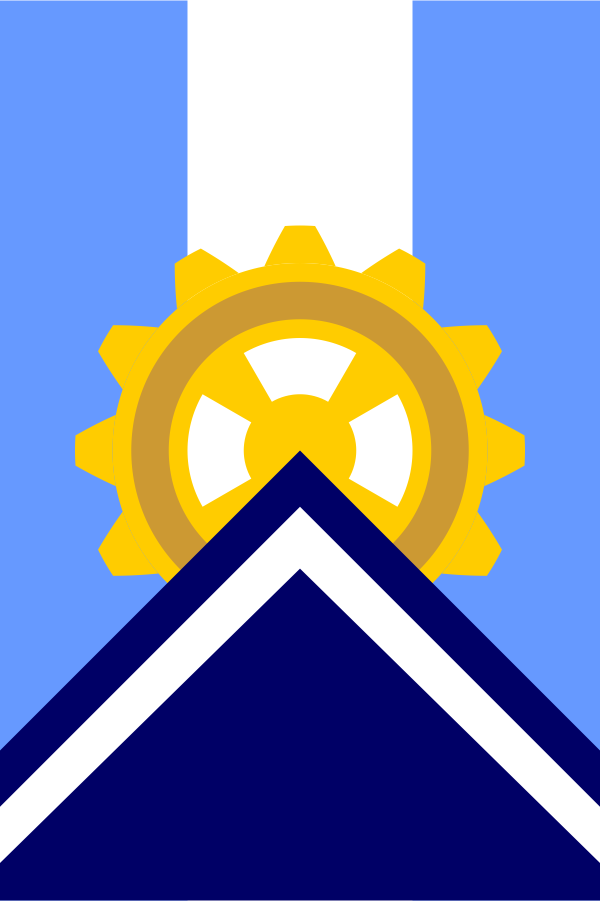Cogstaff
Once a blunt melee weapon wielded by pre-modern Evermornans, the cogstaff has long since become a ceremonial item in Cobalt Protectorate civil government. Specifically, it has become a badge of office of sorts for the Clan Lords of the various Protectorate clans, as well as any officials working in a similar legislative capacity at lower levels of government (i.e. the mayor of an arcology). Despite their evolution, cogstaves remain potent (if somewhat outmoded) self-defense weapons for those who carry them, and significantly less-adorned variants are often carried as walking sticks - especially among the elderly.
Mechanics & Inner Workings
A cogstaff is, in essence, a wooden pole onto which a palm-sized cog has been pressed such that the side of the cog lies flush with the end of the pole. The pole is generally tall enough for the wielder to comfortably rest their hand on top of it in the manner of a cane, though some specimens can be as tall as a fully grown human. Taller cogstaves tend to be topped with a pointed metal fitting up to three inches long. Flagpoles topped with the cog and spike are common, but not generally regarded as cogstaves in the technical sense - they would be difficult to carry in day-to-day life unlike like the original article.
The shape of the cogstaff is reminiscent of the item's original purpose as a disk mace. Before the return of Wurth Harkin to Evermorn sparked a technological golden age, melee combat was a common occurence, and disk maces proved quite effective against armored targets. The blunt cog teeth of the modern cogstaff evolved from the sharp points sometimes found on the striking disk. The optional point was used to give the disk mace an additional utility as a thrusting weapon, with the disk weight providing a backstop to a thrust attack in a manner similar to the cap of a godendag or the crossguard of a boar-hunting spear.
Significance
The cogstaff is a potent cultural symbol among Evermornans, hearkening back to a time of great internicene strife followed by a period of great social and technological advancement brought about by the first return of Wurth Harkin to Planet Evermorn. The change in the cogstaff's design - from brutal spikes and knobs to the shape of a machine part - coincided with Wurth's decree to "go forth, find, and preserve the brothers and sisters of humanity" in the universe. Over time, as Wurth and the exiles which followed him home unified the tribes of Evermorn into the young Protectorate, the cogstaff saw less and less use as a weapon of war, but blunted versions still found use in the hands of peacekeepers. This served to strip the cogstaff of its original frightfulness in the eyes of the law-abiding members of the public.
As such, a cogstaff or flagpole adorned with the cog and spike carries connotations of martial force - but also the Great Ancestors'' stoic restraint in using that force only to preserve human and human-adjacent life and liberty wherever it may be found.
The cog on the Cobalt Protectorate Banner shares a similar symbolism to the one found on the cogstaff: the strength and humanizing quality of tradition merged with the life-giving dynamism of science.
Item type
Weapon, Melee
Related ethnicities
Owning Organization
Rarity
'True' cogstaves are relatively uncommon, being seen mostly in the ceremonial regalia of heads of state. Canes and walking sticks emulating the motifs of cogstaves are more common, though these are not nearly as intricately adorned.
Raw materials & Components
Classical cogstaves were originally stone in construction, with the striking head becoming bronze, and later steel, as Evermornan metallurgy improved. In modern times, with the martial history of the item falling by the wayside in favor of symbolism, the head is often made of highly-polished copper, brass, or blued titanium. As always, the haft is typically made of a stout hardwood, with rarer and more expensive woods being a sign of wealth or prestige within the Clan.




Comments